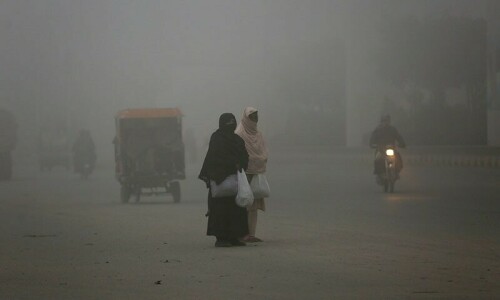According to data released on Tuesday, Pakistan remained one of the three smoggiest countries in the world in 2023, with particulate matter levels around 15 times higher than those advised by the World Health Organization. Bangladesh and India replaced Chad and Iran.
In Bangladesh and Pakistan, the mean levels of PM2.5, which are minute airborne particles that cause lung harm, were found to be 79.9 and 73.7 micrograms per cubic meter, respectively, in 2023.
The WHO advises against taking more than five micrograms.
Christi Chester Schroeder, the air quality scientific manager at IQAir, a Swiss air monitoring company, stated that “you get this streak of PM2.5 concentrations that just skyrocket because the pollution has nowhere to go.” This is due to the climate and topography of South Asia.
“There are other factors like population density, industry, and agricultural practices on top of that,” she continued. “Sadly, it appears that things will worsen before they get better.”
India was placed ninth and Bangladesh fifth in terms of air quality in 2022.
An specialist on air pollution from Dhaka’s North South University, Md Firoz Khan, stated that air pollution causes about 20 percent of premature deaths in Bangladesh and that associated healthcare expenses account for 4–5% of the nation’s GDP.
Last year, PM2.5 readings in India were around eleven times higher than the WHO threshold, indicating an increase in pollution. With 92.7 micrograms, New Delhi, India, was the capital city with the lowest performance.
In China, PM2.5 increased 6.3% to 32.5 micrograms in the previous year, following five years of decreases.
In 2023, the WHO standards were only satisfied by Australia, Estonia, Finland, Grenada, Iceland, Mauritius, and New Zealand.
Based on information from over 30,000 monitoring stations spread throughout 134 nations and regions, the IQAir report was produced.
Due to data problems, Chad, which was the most polluted nation in the world in 2022, was left off of the 2023 listings. Sudan and Iran were also removed from the list for 2023.
According to Christa Hasenkopf, director of the University of Chicago’s Energy Policy Institute’s Air Quality Life Index, 39% of nations lack public air quality monitoring.
“It’s astonishing that we don’t have an organized global effort to deploy resources to close these data gaps, especially in places where the health burden of air pollution has been largest,” the speaker added, pointing out the significant potential advantages and relatively cheap cost.








